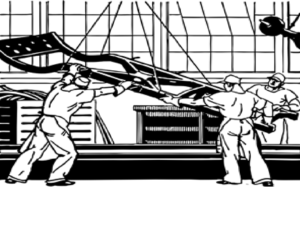The chattering classes are all atwitter over the decline in US manufacturing jobs. And rightly so; the hollowing out of our manufacturing sector is a social problem, a fiscal problem, and even a national security problem.
Now, there are a whole lot of factors that have contributed to the decline in US manufacturing employment, so there are also many different ways to go about fixing things. I’m not going to begin to delve into all of them – that’s a book, not an article.
One key way to start fixing manufacturing in our country, though, is to make the work more appealing to current and potential employees, thereby making domestic manufacturing more appealing to entrepreneurs and investors who can help turn the tide of job loss.
There are a whole lot of factors that come into play here, too. But to mention a few glaring ones, I’ll start with working conditions. Manufacturing oftentimes involves miserably hot or cold work areas, awful odors, safety and health hazards, and hard physical labor. While it’s not financially feasible to make every job completely comfortable, doing what we can to mitigate the unpleasant aspects of the work will help us attract new workers and make our existing ones happier and more productive. That can be anything from modifying the workplace or the job itself to simply offering more or longer breaks from the most difficult jobs. Rotating jobs can often help.
Related to that one is work schedule. I’ve personally concluded that the twelve hour shift schedule commonly used in manufacturing (and in medicine and other industries too) is simply inhumane. You can’t work that schedule and have proper time for the rest of life. We in manufacturing should commit to eliminating it. Equally, overtime can be problematic; it’s a financial boon to the workers and therefore often desirable to them, but it can quickly become a difficulty for both finances and retention, and a detriment to employee health and well-being. Within reason, overtime is not a problem. But when it doesn’t allow for proper rest and recuperation, it’s dangerous and destructive. I don’t believe anybody should ever be scheduled for more than sixty hours in a week, and weeks with work hours approaching that should be the exception, not the rule. Indeed, we should take a hard look at what the time demands are for family, fitness and health, and allow that kind of time out of work, every week, for every employee as a matter of course. (I agree with leadership consultant Amir Ghannad that we leaders should take affirmative steps to support the health and well-being of our workers. As an aside along those same lines, I believe that, given the reality of the opiod epidemic, the current zero-tolerance drug policies of so many employers are destructive and unsustainable. The manufacturing industry should work on a uniform approach to treatment and rehabilitation for current and potential employees.)
In my many years of experience, I find that leadership and worker treatment are often substandard in the manufacturing world. For too long, managers were selected by seniority rather than ability, and we’re still suffering the consequences. Also, manager behavior has often seemingly been aimed at a Darwinian culling of the weak, rather than a proper caring for workers. I recently finished (and loved) Everybody Matters: The Extraordinary Power of Caring for Your People Like Family by Bob Chapman, CEO of Barry-Wehmiller, and Raj Sisodia. The title is self-explanatory, and should be the ideal for all leaders, especially in manufacturing where the work itself is often so trying.
One aspect of worker treatment I’ve come to loathe since I finished the book is the disparity in how we treat “professional” workers and wage employees. The descriptions themselves are telling: are my machine operators and maintenance mechanics not professionals, or are they less professional than my shift supervisors and warehouse manager? Why does one group have to punch a time clock while the other employees come and go as they please? Why do we routinely demonstrate distrust of the workers closest to the core jobs we do? I wanted to cheer out loud when I read Chapman describe how he ordering all his time clocks removed, and walls and cages around spare parts storage areas torn down. That is how we should treat everybody, and those kinds of changes will make manufacturing jobs much more inviting. As Chapman experienced, treating people with dignity also makes them more loyal and more productive. But most important of all, it’s the right thing to do.
The beauty of all the above is that we can do it for ourselves. It doesn’t take an act of Congress or a change in direction at the EPA or OSHA. Every one of us in a leadership position in manufacturing, right now, can begin making the jobs our most important workers perform more appealing – and therefore make our industry more appealing to customers and investors alike.

